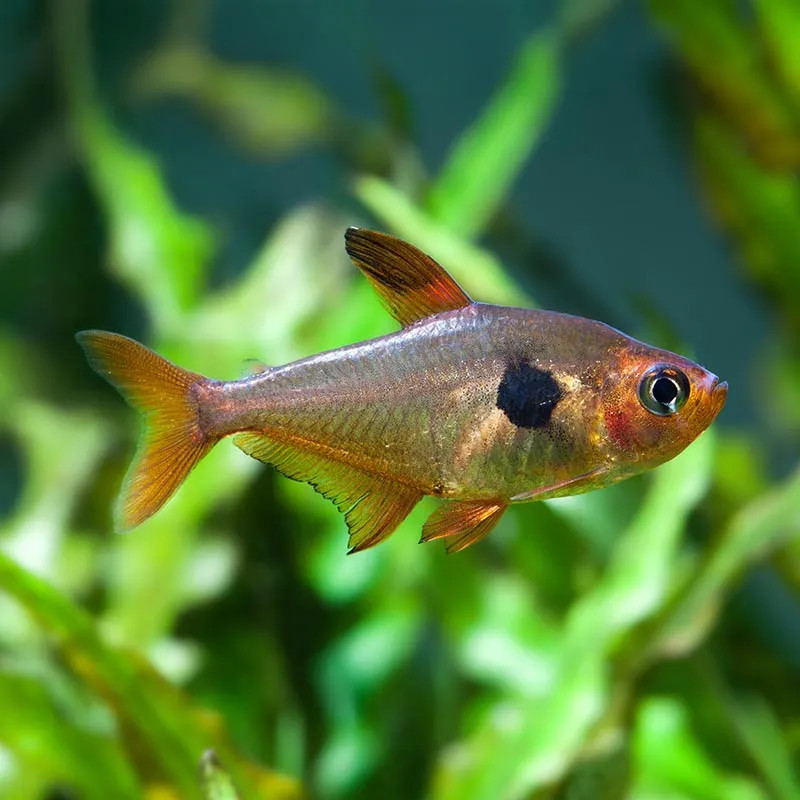Stocks Available
Glowlight Tetra Group
SKU:120688
HEMIGRAMMUS ERYTHROZONUS
1 INCH

Stock Available
Introduction: Species: Rosy Tetra Common Names: Rosy Tetra, Roseyfin Tetra Natural Habitat: Native to the slow-moving rivers and streams of South America, particularly in the Amazon Basin. These fish are typically found in areas with dense vegetation and subdued lighting. Physical Characteristics: Appearance: Rosy Tetras have a deep, laterally compressed body with a soft pinkish hue, giving them their "rosy" appearance. Their fins are often tinted red, with a black marking at the base of the dorsal fin, adding contrast to their delicate coloration. Size: Grows up to 1.5-2 inches (4-5 cm) in length. Lifespan: Average lifespan of 3-5 years with proper care. Habitat Requirements: Tank Size: A minimum of 20 gallons is recommended for a small group. Larger tanks are ideal to allow for better swimming space and proper social dynamics. Water Conditions: Temperature: 72-82°F (22-28°C). pH: 5.5-7.0 (slightly acidic to neutral water). Aquascaping: Mimic their natural environment with soft substrate, dense plant coverage, driftwood, and leaf litter. Dim lighting will help replicate their native habitat, and a well-planted tank provides ample hiding spots. Diet: Primary Diet: Omnivorous; they feed on small invertebrates, algae, and plant matter in the wild. Supplemental Feeding: In aquariums, offer a balanced diet of high-quality flakes, pellets, along with live or frozen foods like daphnia, bloodworms, and brine shrimp. Feeding Frequency: Feed small portions 1-2 times a day for optimal health. Compatibility: Temperament: Peaceful and social, they do best in groups of 6 or more to exhibit natural schooling behavior. Suitable Tank Mates: Compatible with other small, peaceful community fish such as neon tetras, guppies, or dwarf corydoras. Incompatibilities: Avoid keeping them with larger, aggressive species that could bully or prey on them. Care Level: Difficulty: Easy; ideal for beginner aquarists due to their hardy nature and ability to adapt to a variety of water conditions. Health Monitoring: Regularly monitor for signs of stress or disease, such as fin rot or ich, which can be caused by poor water quality. Breeding: Breeding in Captivity: Relatively easy to breed. Provide a separate breeding tank with soft, acidic water and dense plants or spawning mops. Spawning: Rosy Tetras are egg scatterers and do not provide parental care. After spawning, remove the adults to prevent them from eating the eggs. Economic Considerations: Market Demand: Moderate demand among aquarium hobbyists for their striking coloration and ease of care. Wholesale/Retail Pricing: Prices are generally affordable, with captive-bred specimens widely available. Sustainability and Conservation: Wild Population: Not currently under significant threat in the wild, though habitat destruction remains a concern. Aquaculture Efforts: Widely bred in captivity, reducing pressure on wild populations and contributing to sustainability. Regulations: As with all fish species, it's important to comply with local and international regulations concerning their trade. Conclusion: The Rosy Tetra is a charming and peaceful fish, well-suited for community aquariums. Their beautiful rosy hue and easy-care requirements make them a favorite for both novice and experienced aquarists. With the right environment and proper care, Rosy Tetras can thrive, bringing color and life to any aquarium setting.
Data sheet
16 other products in the same category: